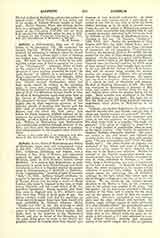

Aldhelm, Saint, Abbot of Malmesbury and Bishop of Sherborne, Latin poet and ecclesiastical writer (c. 639-709). Aldhelm, also written Ealdhelm, Aeldhelm, Adelelmus, Althelmus, and Adelme, was a kinsman of Ine, King of Wessex, and apparently received his early education at Malmesbury, in Wiltshire, under an Irish Christian teacher named Maildubh. It is curious that Malmesbury, in early documents, is styled both Maildulfsburgh and Ealdhelmsbyrig, so that it is disputed whether the present name is commemorative of Maildubh or Ealdhelm, or, by “contamination”, possibly of both (Plummer’s “Bede“, II, 310). Aldhelm himself attributes his progress in letters to the famous Adrian, a native of Roman Africa, but formerly a monk of Monte Cassino, who came to England in the train of Archbishop Theodore and was made Abbot of St. Augustine’s, Canterbury. Seeing, however, that Theodore came to England only in 671, Aldhelm must then have been thirty or forty years of age. The Saxon scholar’s turgid style and his partiality for Greek and extravagant terms have been traced with some probability to Adrian’s influence (Hahn, “Bonifaz und Lul”, p. 14). On returning to settle in Malmesbury our Saint, probably already a monk, seems to have succeeded his former teacher Maildubh, both in the direction of the Malmesbury School, and also as Abbot of the Monastery; but the exact dates given by some of the Saint’s biographers cannot be trusted, since they depend upon charters of very doubtful authenticity. As abbot his life was most austere, and it is particularly recorded of him that he was wont to recite the entire Psalter standing up to his neck in ice-cold water. Under his rule the Abbey of Malmesbury prospered greatly, other monasteries were founded from it, and a chapel (ecclesiola), dedicated to St. Lawrence, built by Aldhelm in the village of Bradford-on-Avon, is standing to this day. (A. Freeman, “Academy”, 1886, XXX, 154.) During the pontificate of Pope Sergius (687-701), the Saint visited Rome, and is said to have brought back from the Pope a privilege of exemption for his monastery. Unfortunately, however, the document which in the twelfth century passed for the Bull of Pope Sergius is undoubtedly spurious. At the request of a synod, held in Wessex, Aldhelm wrote a letter to the Britons of Devon and Cornwall upon the Paschal question, by which many of them are said to have been brought back to unity. In the year 705 Hedda, Bishop of the West Saxons, died, and, his diocese being divided, the western portion was assigned to Aldhelm, who reluctantly became the first Bishop of Sherborne. His episcopate was short in duration. Some of the stonework of a church he built at Sherborne still remains. He died at Doulting (Somerset), in 709. His body was conveyed to Malmesbury, a distance of fifty miles, and crosses were erected along the way at each halting place where his remains rested for the night. Many miracles were attributed to the Saint both before and after his death. His feast was on May the 25th, and in 857 King Ethelwulf erected a magnificent silver shrine at Malmesbury in his honor.
“Aldhelm was the first Englishman who cultivated classical learning with any success, and the first of whom any literary remains are preserved” (Stubbs). Both from Ireland and from the Continent men wrote to ask him questions on points of learning. His chief prose work is a treatise, “De laude virginitatis” (“In praise of virginity”), preserved to us in a large number of manuscripts, some as early as the eighth century. This treatise, in imitation of Sedulius, Aldhelm afterwards versified. The metrical version is also still extant, and Ehwald has recently shown that it forms one piece with another poem, “De octo principalibus vitiis” (“On the eight deadly sins”). The prose treatise on virginity was dedicated to the Abbess and nuns of Barking, a community which seems to have included more than one of the Saint’s own relatives. Besides the tractate on the Paschal controversy already mentioned, several other letters of Aldhelm are preserved. One of these, addressed to Acircius, i.e. Ealdfrith, King of Northumbria, is a work of importance on the laws of prosody. To illustrate the rules laid down, the writer incorporates in his treatise a large collection of metrical Latin riddles. A few shorter extant poems are interesting, like all Aldhelm’s writings, for the light which they throw upon religious thought in England at the close of the seventh century. We are struck by the writer’s earnest devotion to the Mother of God, by the veneration paid to the saints, and notably to St. Peter, “the key-bearer”, by the importance attached to the holy sacrifice of the Mass, and to prayer for the dead, and by the esteem in which he held the monastic profession. Aldhelm’s vocabulary is very extravagant, and his style artificial and involved. His latinity might perhaps appear to more advantage if it were critically edited. An authoritative edition of his works is much needed. To this day, on account of the misinterpretation of two lines which really refer to Our Blessed Lady, his poem on virginity is still printed as if it were dedicated to a certain Abbess Maxima. Aldhelm also composed poetry in his native tongue, but of this no specimen survives. The best edition of Aldhelm’s works, though very unsatisfactory, is that of Dr. Giles (Oxford, 1844). It has been reprinted in Migne (P.L., LXXXIX, 83 sqq.). Some of his letters have been edited among those of St. Boniface in the “Monumenta Germanise” (Epist. Aevi Merovingici, I).
HERBERT THURSTON

